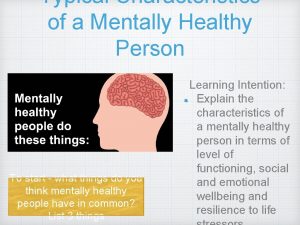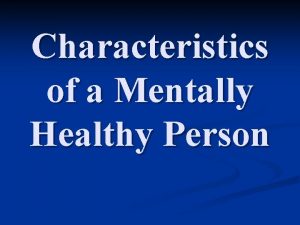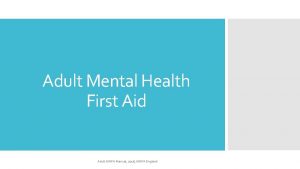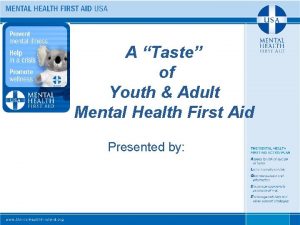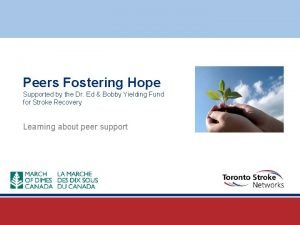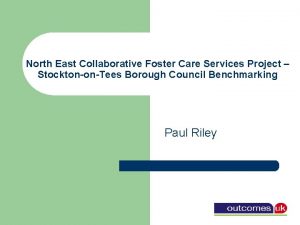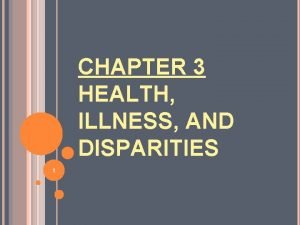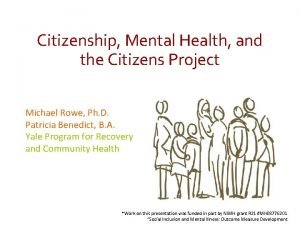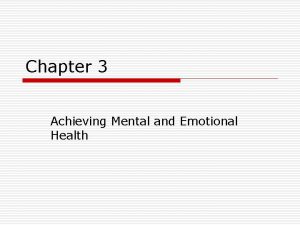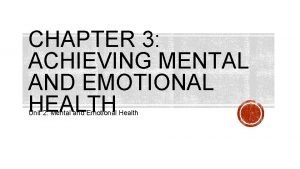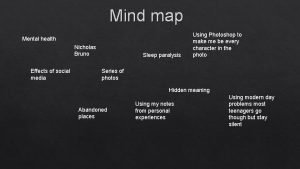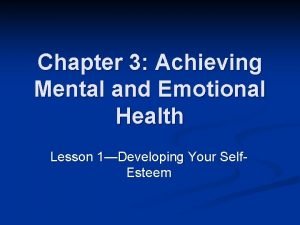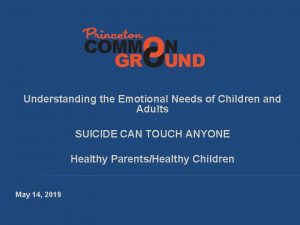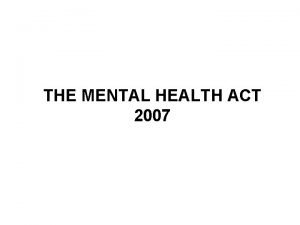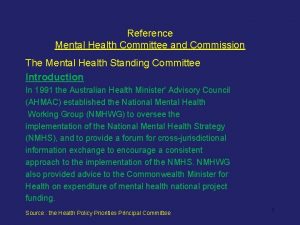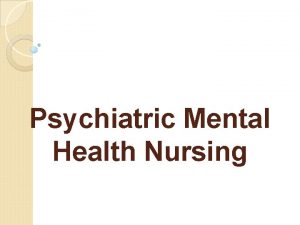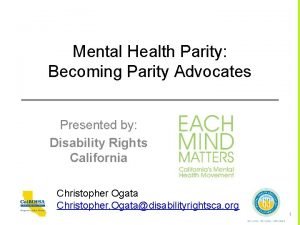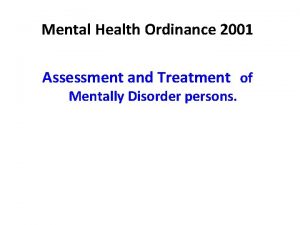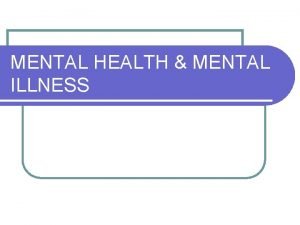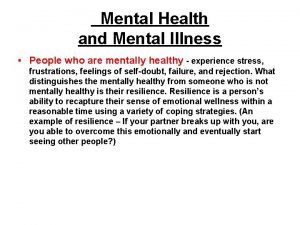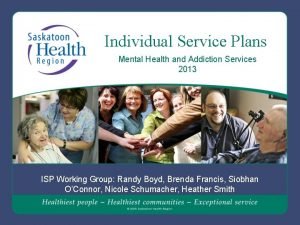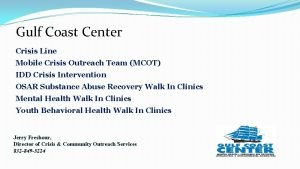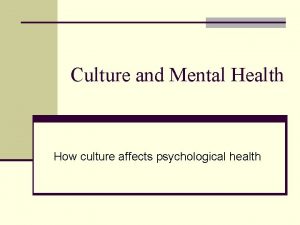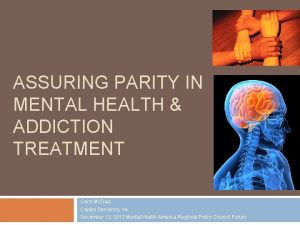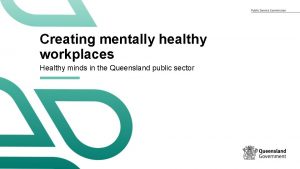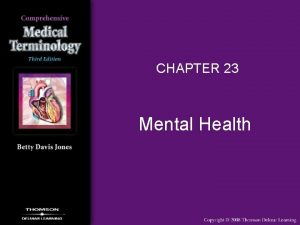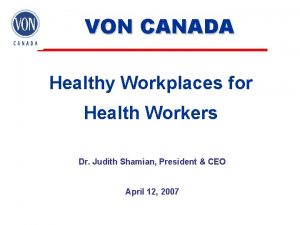Fostering Mentally Healthy Workplaces and Mental Health First


























































































- Slides: 90

Fostering Mentally Healthy Workplaces and Mental Health First Aid EASNA Institute 2014. Plenary 2, 2 -3: 30 pm April 24, 2014 Presented by: Sjors Reijers, Manager of Program Promotions, MHFA Canada+, Mental Health Commission of Canada Sapna Mahajan, Director, Prevention and Promotions, Mental Health Commission of Canada

Who is in the room? /2

Today 1. Overview of the Mental Health Commission of Canada (MHCC) 2. Why should you care? 3. What can you do? – Practical approaches 4. Case Study /3

World Health Organization definition of Health: Health is “a state of (complete) physical, mental and social well-being and not merely the absence of disease or infirmity. ” /4

Public Health Agency of Canada Definition of Mental Health: Mental Health is “the capacity of each and all of us to feel, think, and act in ways that enhance our ability to enjoy life and deal with the challenges we face. It is a positive sense of emotional and spiritual well-being that respects the importance of culture, equity, social justice, interconnections and personal dignity. ” /5

What is a Mental Disorder? A mental disorder causes major changes in a person’s thinking, emotional state and behaviour, and disrupts the person’s ability to work and carry out their usual personal relationships. /6

What are Mental Health Problems? A mental health problem is broader term that includes both mental disorders and symptoms of mental disorders which may not be severe enough to warrant a diagnosis of a mental disorder. /7

Myths and Facts about Mental Health Problems MYTH Mental health problems are rare FACT One in five people will experience a mental health problem in the course of a year MYTH People with mental health problems never recover FACT With the right support most people with mental health problems get better MYTH People with depression could just “snap out of it” if they wanted to FACT People with depression have serious symptoms which aren’t in their control /8

The Mental Health Commission of Canada /9

MHCC Mandate The MHCC is funded by Health Canada and has a 10 -year mandate (20072017). Among its initiatives, the MHCC has just developed the country’s first mental health strategy, is working to reduce stigma, strengthening knowledge exchange capacity in mental health, and examining how best to help people who are homeless and living with mental health problems. Three Strategic Priorities: To Be a Catalyst - MHCC is a catalyst for system and social change that leads to improved mental health for Canadians. To Collaborate - The MHCC collaborates and partners with people and organizations that have a role to play in transforming the mental health system to accelerate change. To Ensure Sustainability - Financial, Organizational, Social / 10

The Mental Health Strategy for Canada and Canadian Workplaces The Strategy calls for the creation of mentally healthy workplaces, including the broadbased adoption of standards for psychological health and safety. / 11

Why should you care? The Issue

2006: Senate Committee publishes Out of the Shadows at Last – first and largest national study on mental health, mental illness and addictions EMPLOYEES have a stake in mental health 2007: The MHCC is created by the Government of Canada …in the workplace / 13

Serious harm is being done to workers that could be prevented or significantly 2006: Senate Committee publishes reduced Out of the Shadows at Last – first and largest national study on mental health, mental illness and addictions This harm is referred to as “mental injury” 2007: The MHCC is created by the Government of Canada Mental injury is a significant but largely ungoverned risk for organizations / 14

Why Focus on Psychological Health and Safety in the Workplace? • By age 40, about 50% of Canadians will have had experience with a mental illness/mental health problem • Adults in their prime working years are among the hardest hit • Psychologically unsafe workplaces can contribute to mental illness / 15

Impact During Prime Working Years • One person in five in Canada will experience a mental health problem or illness in a given year; • People in their early working years are most affected. / 16

2006: Senate Committee publishes Out of the Shadows at Last – first and largest national study on mental health, mental illness and addictions EMPLOYERS have a stake in mental health 2007: The MHCC is created by the Government of Canada …in the workplace / 17

Converging legal pressures to provide a psychologically safe work environment – 7 major Trends Employment Standards Legislation Labour Relations Law Duty to Provide a Psychologically Safe Workplace Employment contract / 18 Occupational Health and Safety Legislation Human Rights Legislation Law of Torts (negligence ) Workers Compensation Law

Risk Management: Dr. Martin Shain said. . . A Changing legal climate - • We can characterize these trends as pressures building toward a perfect legal storm, where the whole is far greater than the sum of the parts. • A psychologically safe workplace is no longer a “nice to do”. It is now a “must do” • There is a rising tide of liability for employers who fail to provide a psychologically safe work environment; • Employers lack the tools to assess and address workplace risks to psychological health and safety; / 19

Impacts on Absenteeism In Canada, mental health is the leading cause of both STD and LTD, in the U. S. it is the 4 th greatest cause for STD and the 3 rd for LTD Companies with the most effective health and productivity programs: § 11% > revenue per employee § < medical trends by 1. 2% § 1. 8 fewer days absent per employee § 28% > shareholder returns / 20

Recruitment and Retention Employees today expect organizations to support personal and professional growth – good mental health is one of the keys to success Attracting employees in a competitive market is a challenge Prospective employees are looking for the “right culture” to support their personal and professional ambitions Positive workplace mental health enhances organizational sustainability, including employee recruitment and retention; Engaged employees generate 43% more revenue than disengaged ones; (Hay Group – “Engage Employees and boost performance 2001”). / 21

Standards or Regulations ? Standards or Regulations? • Standards are voluntary: • unless adopted or referenced in legislation; • General duty clause may imply compliance with standards; • Many areas of law already addressing PHS in the workplace; • Mandatory and informative clauses in standard; • Care taken to specify that standard is intended to be voluntary. / 22

The Business Case 1. Corporate Social Responsibility: • Includes employees as well as external stakeholders; 2. Cost Effectiveness: • In productivity as well as cost trend management; 3. Recruitment and Retention: • The competition for talent; 4. Risk Management: • OH&S, Human Rights, Disability Legislation. / 23

2006: Senate Committee publishes Out of the Shadows at Last – first and largest national study on mental health, mental illness and addictions CANADA has a stake in mental health 2007: The MHCC is created by the Government of Canada …in the workplace / 24

The Economic Cost $50 billion annual loss to Canadian economy 30% of disability claims 70% of total disability costs / 25

Working - is it good for mental health? Time off and return to work: The longer someone is off, the less chance there is of a successful return to work 6 months off – 50%, 9 months – 10% Focus on prevention and early intervention Disability duration is less when: There is positive mental health (all disabilities) Good coping strategies for stressors exist Workplace issues are resolved quickly / 26

Activity: Penny Draw / 27

Activity: Penny Draw / 28

What can you do? Practical Approaches

Mental health is a shared responsibility • All responsible for own mental health; • 2/3 of Canadians are at work 60% of their life time; • The workplace is not always part of the problem, but it can always be part of the solution; TED Talks: Dan Ariely: http: //www. ted. com/talks/dan_ariely_what_makes_us_f eel_good_about_our_work. html / 30

Employee – Front and Centre • PROMOTE GOOD MENTAL HEALTH AND PREVENT PSYCHOLOGICAL HARM FOR EVERY EMPLOYEE IN YOUR ORGANIZATION • PEOPLE LIVING WITH MENTAL ILLNESSES OFTEN SAY THAT THE STIGMA THEY ENCOUNTER IS WORSE THAN THE ILLNESS ITSELF • Reduce stigma and discrimination related to mental illness • Create an environment that is respectful and inclusive of mental health disabilities Reduce Stigma Change The Culture Of Your Organization • Implement organization-wide policies and procedures to foster a mentally healthy and safety environment for your employees • National Standard EMPLOYEE • SUPPORT THOSE WITH LIVED EXPERIENCE TO GET BACK TO WORK AND PURSUE PRODUCTIVE LIVES Support Those With Lived Experience Understand Mental Health and Illness • PSYCHOLOGICAL FIRST AID IS JUST AS IMPORTANT AS PHYSICAL FIRST AID / 31 • Improve your organization's

Educate, Educate Understand Mental Health and Illness / 32

Aims of First Aid Preserve life Prevent deterioration of injury or illness Promote healing Provide comfort to the ill or injured / 33

Aims of Mental Health First Aid Preserve life where a person may be a danger to themselves or others Provide help to prevent the mental health problem from becoming more serious Promote the recovery of good mental health Provide comfort to a person experiencing a mental health problem / 34

Why Mental Health First Aid? • Mental health problems are common • Professional help is not always on hand • Members of the general public often do not know how to respond • There is stigma associated with mental health problems • Not everyone with a mental health problem seeks treatment • People may lack the insight to realize that they need help or that help is available • Many people are not well informed / 35

Evidence Based Outcomes Significantly greater recognition of the most common mental health disorders Decreased social distance from people with mental disorders Increased confidence in providing help to others Demonstrated increase in help actually provided / 36

The Course Basic Adult: 12 hours / 2 days / 4 sessions Adults who work with Youth: 14 hours / 2 days / 4 sessions Instructor Training: 5 days – basic / 5. 5 days - youth / 37

Signs and Symptoms Recognizing signs and symptoms of developing mental health problems: - Substance Related Disorders - Mood Disorders - Anxiety Disorders - Psychotic Disorders - Deliberate Self-Injury (Youth Course) - Eating Disorders (Youth Course) / 38

Crisis First Aid Mental Health First Aid is the help provided to a person developing a mental health problem or experiencing a mental health crisis: • Suicidal behaviour • Overdoses • Panic Attacks • Reactions to traumatic events • Psychotic episodes / 39

Making the Case for Investment Course options: 1. Send staff to become MHFA instructors 2. Attend a public MHFA course 3. Host an MHFA course in your workplace How managers and staff work together to make mental health a priority for workplace health and safety: / 40

So what? / 41

Support the Employee Change The Culture Of Your Organization / 42

A National Standard • Global Business and Economic Roundtable on Addiction and Mental Health • Martin Shain, Ph. D – seven areas of law trending towards employers’ increasing responsibility • Consensus Conference (2009) of business, labour, clinicians and other stakeholders • Vancouver, BC (2010) group : seek information about providing a psychologically safe workplace • Technical committee established (2011) Standard released January 16, 2013 / 43

Purpose of Standard Prevent psychological harm from conditions in the workplace. Promote psychological health in the workplace through support. / 44

Who Developed the Standard? Funding Support Technical Committee Organization interest | Employee/Labour interest Regulator/Insurance/Policy interest | Service provider interest | General interest / 45

National Standard of Canada • Published January 16, 2013; • No cost for the first 5 years; (or until the first major revision whichever is first); Available from BNQ and CSA: CSA BNQ www. csa. ca/z 1003 English : www. bnq. qc. ca/can-csaz 1003 -bnq 9700 -803/en French: www. bnq. qc. ca/can-csaz 1003 -bnq 9700 -803/fr / 46

What is the Standard? The Standard is a guide that offers organizations a structure and process for changing how mental health and mental illness are approached in the workplace. • Voluntary • Aligned on existing standards and tools • It is applicable to any organization • Intended to enable both employers and employees to measure progress • Informative annexes are included to help users develop approach to implementation and integration / 47

The BNQ-CSA standard – PH and S in the workplace Aligns with Existing Standards and Tools: § BSI PAS 1010 Guidance on the management of psychosocial risks in the workplace; § § BNQ 9700 -800/2008 “Healthy Enterprise”; § CAN/CSA Z 1000 -06 Occupational Health and Safety Management; § Draft CSA Z 1002 “OHS Hazards and Risks”; § Other reference material (e. g. . Guarding. Minds@Work). / 48

Overview of the Standard Leadership / 49 Promotion of Mental Health Stigma Reduction The Standard

STANDARD – GUIDING PRINCIPLES Commitment by Senior Management Participation with all Integration of PHS Shared responsibility Focus on health, safety, awareness and promotion / 50

5 Elements + Annexes Commitment, Leadership and Participation Management Review / 51 Evaluation and Corrective Action Planning Implementation

Unique Aspects of the Standard • A global first for psychological health and safety • A set of tools and not rules • Adaptable and flexible for employers of all sizes and sectors – no one size fits all • The Standard is for everyone and is a shared responsibility; everyone plays a key role • Promotion and prevention • Available at no cost for the first five years or until a major revision / 52

One year later 1. More than 16, 000 downloads of the Standard 2. Key industry champions such as Province of Nova Scotia, Bell Canada, University of Waterloo, General Electric, etc. are stepping up to the challenge and adopting the Standard 3. Technical Committee that developed the Standard continues to drive adoption and work with organizations in Canada, e. g. Great-West Life Centre for Mental Health, Canadian Mental Health Association, Workplace Safety and Prevention Services etc. 4. Standard generated both national and international interests, e. g. Australia was recently given the rights to use the Standard and to develop guidelines / 53

MHCC Moving Forward PROMOTION DRIVE ADOPTION Free Webinars Case Study Research Project Collaborative Spaces Roundtable Discussions Re-designing of the workplace webpage Stakeholder Engagement “Share your Story” online survey Partnerships, e. g. Groupe Entreprises en Santé, Lundbeck Canada, Great-West Life Centre for Mental Health, TELUS, WSPS etc. Conferences & Meetings – booths, speeches Social Media Newsletters, magazine articles, press / 54 releases, media interviews Educational Tools Government Relations

MHCC is being asked • In one year of the Standard’s life, significant interest has been generated and several early adopters have come forward • Questions being consistently asked to the MHCC: - Who, in my industry, is adopting the Standard? - What are some of promising practices? - What are the lessons learned from other organizations? - What tools/resources can I use in my environment? - I’m a small organization, does the Standard apply to me? If yes, how can an organization of my size implement the Standard? • The Case Study Project aims to answer these questions and drive adoption and uptake of the Standard / 55

Canada’s successes in advancing the issue MHCC announced plans to further work with Canadian businesses and drive uptake of the Standard in workplaces across Canada A new $1. 4 -million research project to assess the impact of a federally funded program aimed at improving mental health in the workplace was announced / 56

Case Study Project 1. Document how the National Standard is being implemented among Canadian employers, in various industries, sectors, regions and of various sizes 2. Identify challenges, gaps and promising practices related to implementation 3. Quantify costs and impact Expected Outcome s / 57 • Blueprint for future organizations that wish to adopt the Standard • Identification and Dissemination of Promising Practices • Inform Future Revisions of the Standard • Strong Business Case • Identify gaps and challenges

Champion Participating Organizations • • • • / 58 AGS Rehab Solutions Alberta New Home Warranty Program Bell Canada Belmont Health & Wealth Bernardi Human Resources Law LLP Canadian Mental Health Association – Toronto Branch Cape Breton Health District Authority Capital Health District Authority (Nova Scotia) Community Resource Connections of Toronto County of Frontenac Community Mental Health and Addiction Services Garden City Family Health Team Great-West Life Assurance Company Habitat for Humanity – Nova Scotia Haliburton, Kawartha, Pine Ridge District Health Unit • • • • Immigrant Settlement and Integration Services (Halifax, Nova Scotia) Lakeridge Health Manulife Financial Mount Sinai Hospital Nova Scotia Government and General Employees Union Pickering Public Library Provincial Health Services Authority (British Columbia) Real Estate Board of Greater Vancouver School District #22 The Regional Municipality of York The Royal Ottawa Health Care Group The Scarborough Hospital Toronto East General Hospital University Health Network

So what? / 59

Assist the Aspiring Workforce Support Those With Lived Experience / 60

How disabling are mental health problems? “Disability” refers to the amount of disruption that a health problem causes to a person’s ability to work, look after themselves, and carry on their relationships. Moderate depressions is similar in disability to deafness. Severe PTSD is comparable to paraplegia / 61

Activity: Rank the Disorders • Each table has a slips of paper with physical and mental disorders • As a group, rank them in order from least disabling to most disabling • Some can be equally disabling • 7 minutes to complete the exercise / 62

Results (from least to most disabling): gingivitis mild asthma low back pain uncomplicated diabetes mild depression epilepsy mild/moderate panic disorder anorexia mild/moderate obsessive compulsive disorder Moderate depression severe asthma Severe vision loss complete hearing loss Severe schizophrenia / 63 quadriplegia chronic hepatitis B infection operable small cell lung cancer Severe post traumatic stress disorder Severe depression non-invasive breast cancer paraplegia brain injury with permanent impairments end-stage Parkinson’s disease severe dementia

The numbers of people with mental illness transitioning onto disability income support programs are rising / 64

THE PROBLEM Up to 90% of Canadians with serious mental illness are unemployed The skills and talents of people with serious mental illness are often not recognized; their potential contribution to economic and civic life is wasted Barriers to employment for people with serious mental illness include: » » » / 65 Stigma and discrimination Income security policies that penalize (or fail to sufficiently reward) earned income Inadequate sustained support for people in getting – and keeping – a job

WE KNOW People with a job are healthier, have higher selfesteem, and have higher standards of living Most people with serious mental health problems have skills and expertise to offer to the labour market – they can work, and want to work / 66

Aspiring Workforce Initiated through the Workforce 2006: Senate Committee publishes Advisory Committee at the Mental Out of the Shadows at Last – first Health Commission of Canada and largest national study on mental health, mental illness and addictions A report, comprised of five components, that aims to provide 2007: The MHCC is created by the recommendations to help Canadians Government of Canada with mental health problems or illnesses get back to work / 67

Aspiring Workforce: The Partnership / 68

The Aspiring Workforce Represent “those people who, due to mental illness have been unable to enter the workforce, or who are in and out of the workforce due to episodic illness, or who wish to return to work after a lengthy period of illness. ” (Centre for Addiction and Mental Health) / 69

The Aspiring Workforce The Economic Cost • People living with a mental illness who work use far fewer hospital and other health services than those without jobs. • Approximately $28. 8 billion is spent each year in disability income support. Of that, it’s projected that $9. 6 billion is for people living with a mental health problem or illness. The Human Cost • Unemployment is linked to stress and instability, problems with self-esteem, relational conflicts, substance use and other concerns. • Unemployment is associated with a two to threefold increased risk of death by suicide, when compared with employment.

THE RIGHT ACTORS People with mental illness Federal Governments Provincial Governments Employers Community Organizations Territorial Governments Mental Health service Providers / 71

THE RIGHT BEHAVIOURS De-stigmatize people with serious mental illness / 72 Build system capacity Remove disincentives to return to work Intervene early on Invest in existing best practices and test new strategies Collaborate across the continuum

THE RIGHT ANSWERS The right employment supports Alternative employment options The right information The right incentives / 73

Aspiring Workforce: 5 components 2006: Senate Committee publishes Out of the Shadows at Last – first 1. Supported Employment: A Review of the Literature and largest national study on mental Canadian Perspectives health, mental illness and addictions 2. An Overview of Provincial Disability Programs and Work 2007: The MHCC is created by the Incentives/Disincentives 3. Government of Canada Environmental Scan of Social Businesses 4. A Legislative Model of Income Supports for People with Mental Illness 5. Workplace Know-How / 74

So what? / 75

There is stigma associated with mental health problems Imagine if we treated everyone like we treat people with mental illness. / 76



Address Stigma Reduce Stigma / 79 Opening Minds

Stigma in the Workplace • 46% of Canadians agreed that “we call some things mental illness because it gives some people an excuse for their poor behaviours and personal failings” (CMA, 2008) • 38% of Canadians would be embarrassed to admit their children has anxiety or depression (Kinark Child and Family Services, 2007) • Only 23% of Canadians surveyed said that they would completely agree or somewhat agree with the statement that they feel comfortable talking to my employer about their mental disorder (Canadian Medical Association, 2008) • “Only 26% of surveyed employees feel that their supervisor effectively manages mental health issues” (Thorpe & Chenier, 2011) / 80

Earlier help. Reducing Stigma in the Workplace seeking Better prognosis & outcome Reducing Stigma in the Workplace More supportive workplace for all Increase productivity Positive financial impact / 81

Reducing Stigma in the Workplace OM’s approach is not to “reinvent the wheel” but to take an in-depth look at existing anti-stigma programs Partner with organizations and companies to implement anti-stigma and mental health and wellbeing initiatives Scientifically evaluate them for efficacy and financial impact Take best and promising practice from other sectors and adapt them to the general workforce (e. g. , R 2 MR to The Working Mind) / 82

Opening Minds Workplace Partners & Projects

Workplace Programs Over 15 partnerships in various sectors (e. g. , private, education, government) across Canada Many other partners in discussions Evaluations are well underway Preliminary results are very promising - Programs decrease the stigma of mental illness - Increase awareness of mental health in the workplace - Employees and organizations very receptive of programs / 84

So what? / 85

Case Study - MHCC

Improving Mental Health in the MHCC Workplace / 87

Any questions? / 88

Resources Download the Standard for free, www. csa. ca/z 1003 Download the Action Guide for Employers, which provides guidelines that encourage executive leadership to commit to making mental health in their workplace a priority, http: //www. mentalhealthcommission. ca/English/node/505? terminitial=30 Share your Story , http: //www. mentalhealthcommission. ca/English/standardform Join us on our next free webinar on the Standard, www. mentalhealthcommission. ca/English/workinar Learn more about the work being done at the MHCC to reduce stigma in the workplace, http: //www. mentalhealthcommission. ca/English/initiatives-and-projects/opening-minds Download the research report, the Aspiring Workforce to learn on recommendations to assist the aspiring workforce to return to and maintain productive work, http: //www. mentalhealthcommission. ca/English/aspiring-workforce Check out the Great West Life Centre for free tools and resources, http: //www. gwlcentreformentalhealth. com/ Train employees in Mental Health First Aid so they can recognize emerging mental health problems or crises in themselves and their colleagues, and provide initial help, www. mentalhealthfirstaid. ca Take advantage of the free and comprehensive set of resources offered by Guarding Minds at Work to help protect and promote psychological health and safety in the workplace, http: //www. guardingmindsatwork. ca/ Learn about additional solutions for employers and supports for employees offered by Mental Health Works, a national program of the Canadian Mental Health Association, http: //www. mentalhealthworks. ca/ 89 Join /Partners for Mental Health in taking the pledge to support the improvement of mental health for all Canadians, www. partnersformh. ca

Thank you! Contact us: nrewari@mentalhealthcommission. ca or sreijers@mentalhealthcommission. ca Visit: www. mentalhealthcommission. ca Follow us: The views represented herein solely represent the views of the Mental Health Commission of Canada. Production of this document is made possible through a financial contribution from Health Canada. / 90
 Healthy workplaces for all ages
Healthy workplaces for all ages Healthy workplaces campaign
Healthy workplaces campaign Fostering healthy solutions
Fostering healthy solutions Qualities of mentally healthy person
Qualities of mentally healthy person Self actualization qualities
Self actualization qualities Mental health and mental illness chapter 20
Mental health and mental illness chapter 20 Mental health jeopardy questions and answers
Mental health jeopardy questions and answers Creativity and play fostering creativity
Creativity and play fostering creativity Fostering teamwork
Fostering teamwork Mhfa reference guide
Mhfa reference guide Algee action plan steps
Algee action plan steps Mental health first aid
Mental health first aid Fostering hope scholarship
Fostering hope scholarship Fostering stockton on tees
Fostering stockton on tees Fostering in doncaster
Fostering in doncaster Journal on healthy food healthy mind
Journal on healthy food healthy mind Healthy soil healthy life poster ideas
Healthy soil healthy life poster ideas Healthy forests healthy communities poster contest
Healthy forests healthy communities poster contest Healthy nurse healthy nation
Healthy nurse healthy nation Lesson 3 add and subtract mentally
Lesson 3 add and subtract mentally How to multiply fractions mentally
How to multiply fractions mentally How to divide fractions mentally
How to divide fractions mentally Matteo is 4 feet 3 inches tall
Matteo is 4 feet 3 inches tall Previewing helps the audience mentally organize a speech
Previewing helps the audience mentally organize a speech Which design principle involves mentally dividing
Which design principle involves mentally dividing Corporate athlete personal development plan
Corporate athlete personal development plan Mentally spiritually physically emotionally
Mentally spiritually physically emotionally Dancing the
Dancing the Feigned insanity forensic
Feigned insanity forensic Assimilate mentally
Assimilate mentally Chapter 3 achieving mental and emotional health answer key
Chapter 3 achieving mental and emotional health answer key Mental health and older adults
Mental health and older adults Lemhwa report to congress
Lemhwa report to congress Mental health and older adults
Mental health and older adults Mental health and citizenship
Mental health and citizenship Chapter 3 achieving mental and emotional health
Chapter 3 achieving mental and emotional health Chapter 21 mental health diseases and disorders
Chapter 21 mental health diseases and disorders Chapter 15 achieving mental and emotional health answer key
Chapter 15 achieving mental and emotional health answer key Psychology, mental health and distress
Psychology, mental health and distress Mental health policy, plans and programmes michelle funk
Mental health policy, plans and programmes michelle funk Glencoe health chapter 5 review answers
Glencoe health chapter 5 review answers Chapter 5 mental and emotional problems lesson 2 answer key
Chapter 5 mental and emotional problems lesson 2 answer key A firm observance of core ethical values
A firm observance of core ethical values Chapter 3 achieving mental and emotional health
Chapter 3 achieving mental and emotional health Emotional health defintion
Emotional health defintion Chapter 15 achieving mental and emotional health answer key
Chapter 15 achieving mental and emotional health answer key Mental health mind map
Mental health mind map Whooley questions nice
Whooley questions nice Chapter 3 mental and emotional health
Chapter 3 mental and emotional health Chapter 3 achieving mental and emotional health
Chapter 3 achieving mental and emotional health Chapter 3 achieving mental and emotional health
Chapter 3 achieving mental and emotional health Lesson 2 developing personal identity and character
Lesson 2 developing personal identity and character Chapter 3 achieving mental and emotional health
Chapter 3 achieving mental and emotional health Chapter 15 achieving mental and emotional health
Chapter 15 achieving mental and emotional health First nations mental wellness continuum framework
First nations mental wellness continuum framework Health and social care component 3 health and wellbeing
Health and social care component 3 health and wellbeing Papu frankston
Papu frankston Lenawee community mental health authority
Lenawee community mental health authority Van buren community mental health
Van buren community mental health Together for mental health
Together for mental health 2007 mental health act
2007 mental health act 3 sides of the health triangle
3 sides of the health triangle Introduction to mental health awareness presentation
Introduction to mental health awareness presentation Health committee introduction
Health committee introduction Public mental health
Public mental health Psychiatric nursing meaning
Psychiatric nursing meaning 3 part nursing diagnosis examples
3 part nursing diagnosis examples Mental health programme
Mental health programme Objectives of mental health programme
Objectives of mental health programme Benefits of phr
Benefits of phr Roadmap to success
Roadmap to success Toolbox talk on mental health
Toolbox talk on mental health Golden thread clinical documentation
Golden thread clinical documentation Mental health equity
Mental health equity Mental health ordinance
Mental health ordinance Axis 1-5 mental health
Axis 1-5 mental health Mental health learning objectives
Mental health learning objectives What is mental health
What is mental health Objective for mental health awareness
Objective for mental health awareness Poem on mental health awareness day
Poem on mental health awareness day Mental health trivia
Mental health trivia Billy corgan mental health
Billy corgan mental health Mental health america san diego
Mental health america san diego Individual service plan
Individual service plan How sport affects health
How sport affects health Gulf coast center angleton texas
Gulf coast center angleton texas Influence of culture on mental health
Influence of culture on mental health Bexar county mental health services
Bexar county mental health services Thomas snyder mental health
Thomas snyder mental health Mental health skill building interventions examples
Mental health skill building interventions examples Mental health equity
Mental health equity



